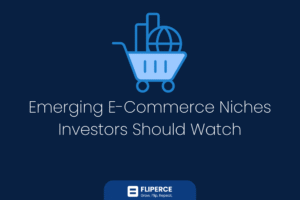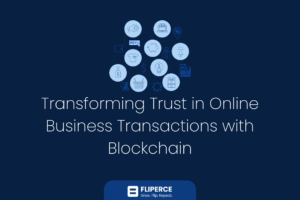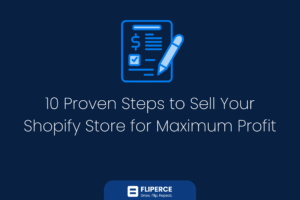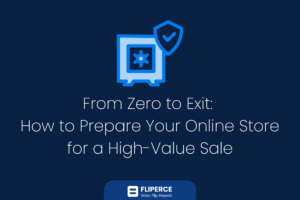Introduction
In 2025, the global e-commerce market, valued at $8 trillion, is a dynamic arena for investors, with platforms like Shopify powering over 4.4 million stores and driving $1 trillion in sales, per industry data. E-commerce investing is a prime wealth-building opportunity, with acquisition marketplaces reporting a 30% surge in deals, averaging $200,000 each. The market is poised to grow 25% by 2026, fueled by AI personalization, social commerce, and sustainability.
This 20-section guide, crafted for advanced investors, entrepreneurs, and developers, explores the most impactful trends shaping e-commerce investing in 2025 and beyond. Organized into four thematic categories—Technology-Driven Trends, Consumer Behavior Shifts, Operational Innovations, and Market Expansion Strategies—each section uses unique formats like investor scenarios, trend forecasts, and success stories to keep you engaged. Packed with actionable strategies, tools, and real-world insights, this article equips you to maximize returns and navigate risks in a competitive landscape. Let’s dive into the future of e-commerce investing.
What You Will Learn
- 20 trends defining e-commerce investing in 2025.
- Strategies to identify high-potential opportunities.
- Tools for data-driven decision-making.
- Insights into emerging technologies and markets.
- Practical steps to boost profitability and reduce risks.
Part 1: Technology-Driven Trends
1. AI-Powered Personalization at Scale
Investor Scenario: The AI Edge
You’re evaluating two beauty stores. Store A uses generic product pages, while Store B employs AI to recommend serums based on skin type, boosting conversions by 20%. Store B sells for $600,000, a 15% premium, due to its AI-driven personalization. In 2025, 30% of e-commerce platforms adopt AI tools, increasing average order values by 15%. AI analyzes customer behavior with 85% accuracy, enabling tailored offers and predictive marketing, critical as 60% of consumers expect personalized experiences.
Why It’s a Game-Changer
AI personalization drives 30% higher retention and 25% sales uplifts. A wellness store using AI for supplement suggestions sold for $500,000, showcasing its value. Tools like Shopify’s recommendation apps process 10,000+ transactions daily, making AI-integrated stores prime investment targets.
How to Invest
- Seek stores with AI recommendation engines, like Dynamic Yield, achieving 10% higher cart values.
- Analyze conversion uplifts (5%) and retention (30%) in due diligence.
- Prioritize cloud-based AI systems for scalability in niches like beauty.
- Partner with AI vendors like Algolia to enhance portfolio stores.
- Train teams on AI dashboards for real-time insights.
Success Snapshot
A skincare store’s AI system increased order values from $50 to $65, selling for $600,000. Its 30% retention rate, driven by personalized upsells, was a key selling point.
Tools and Metrics
| Tool | Function | Benefit |
| Shopify Flow | Automation | 20% efficiency gain |
| Dynamic Yield | Personalization | 15% conversion uplift |
Risks and Rewards
- Reward: 20% higher valuations for AI-driven stores.
- Risk: Over-reliance on AI can lead to 10% churn without human support. Mitigate with hybrid systems.
Expert Quote:
“AI personalization is the future of e-commerce, turning data into dollars,” says a technology strategist.
2. Blockchain for Supply Chain Transparency
Success Story: From Doubt to Dollars
In 2024, a fair-trade coffee store struggled with consumer skepticism about its sourcing. By adopting blockchain to verify bean origins, it reduced fraud claims by 15% and sold for $600,000 in 2025, a 20% premium. Blockchain’s immutable ledgers ensure transparency, cutting costs by 10% via smart contracts, making it a hot trend for investors targeting niches like organic beauty, where 70% of consumers demand authenticity.
Investment Opportunities
- Target stores using blockchain tools like IBM’s Food Trust, reducing fraud by 20%.
- Prioritize platforms with smart contracts for automated supplier payments.
- Focus on niches like fair-trade fashion, where transparency drives 25% of sales.
- Assess fraud reduction (15%) and audit frequency (monthly) in due diligence.
Practical Insights
Blockchain verifies product provenance, appealing to investors seeking trust-driven assets. A store with blockchain-tracked cotton sold for $550,000 due to its credibility.
How to Get Started
- Audit blockchain integration, like Ethereum-based ledgers.
- Partner with providers like VeChain for portfolio stores.
- Monitor adoption, projected at 25% by 2026.
Investor Considerations
- Upside: 20% valuation premiums for transparent stores.
- Downside: High setup costs ($50,000) can deter small stores. Mitigate with shared networks.

3. Augmented Reality (AR) Shopping Experiences
Q&A: Unpacking AR’s Potential
Q: Why invest in AR? AR boosts conversions by 25% with virtual try-ons, critical in fashion. Q: What metrics matter? Look for 10% conversion uplifts and 5% longer sessions. Q: What’s the catch? Setup costs ($50,000) can strain budgets, but established stores mitigate this. A fashion store with AR try-ons sold for $550,000, appealing to 60% of buyers.
Why It’s Hot
AR enhances engagement in niches like cosmetics, where visualization drives 20% higher sales. By 2026, 20% of platforms will adopt AR, making it a key investment focus.
How to Capitalize
- Seek stores with Shopify AR or Snap’s AR Lens for virtual trials.
- Verify AR-driven sales (10% uplift) in analytics.
- Prioritize fashion and furniture niches.
- Partner with AR providers like Snap to enhance portfolio stores.
Practical Example
A cosmetics store’s AR makeup try-ons increased conversions from 5% to 8%, selling for $600,000. Its 20% order value boost was a key metric.
Investor Tips
- Test AR functionality for seamless try-ons.
- Monitor AR adoption, projected at 30% by 2027.
- Risk: High costs can reduce ROI by 5%. Mitigate with scalable platforms.
4. Voice Commerce Integration
Trend Forecast: The Voice Boom
Voice commerce is set to drive 20% of online sales by 2026, with 15% of shoppers using voice search in 2025. A gadget store with Alexa-integrated search sold for $400,000, a 15% premium, due to its 10% traffic boost. Investors prioritize voice-optimized stores, as accessibility becomes a consumer priority.
Investment Strategies
- Target platforms with voice search APIs, like Shopify’s voice integration.
- Verify voice traffic (10%) and conversions (5% uplift).
- Focus on scalable voice APIs for niches like electronics.
- Partner with Google Assistant for portfolio stores.
Vision for 2025
Voice commerce enhances user experience, with stores processing 1,000 daily queries gaining 12% traffic. A store with voice search sold for $450,000 due to its forward-thinking approach.
How to Engage
- Check voice optimization in analytics.
- Test voice search accuracy.
- Train teams on voice query optimization.
- Track growth, at 25% annually.
Investor Outlook
- Upside: 15% valuation premiums for voice-enabled stores.
- Downside: Search errors can reduce conversions by 5%. Mitigate with regular testing.
5. Predictive Analytics for Inventory Management
Investor Playbook: Smart Stocking
You’re eyeing a home decor store with $100,000 profit. Its AI-driven forecasting reduces overstock by 15%, saving $20,000 monthly, leading to a $550,000 sale. Predictive analytics boosts value by 20%, with 4x/year turnover rates. Investors value 85% accurate demand forecasts, critical for high-growth niches.
Key Strategies
- Seek stores with Inventory Planner for 10,000+ SKUs.
- Verify turnover (4x/year) and cost savings (10%).
- Prioritize AI-driven inventory systems.
- Partner with Forecastly for portfolio stores.
Practical Guidance
A store with predictive analytics sold for $520,000, with 95% stock availability. Train teams on predictive dashboards to ensure efficiency.
Steps to Success
- Audit predictive tools.
- Request turnover data.
- Monitor adoption, at 35% by 2026.
- Risk: Inaccurate forecasts can cause 5% stock issues. Mitigate with hybrid systems.
Key Metrics
- Turnover rate: 4x/year.
- Cost savings: 10%.
- Stock availability: 95%.
Part 2: Consumer Behavior Shifts
6. Social Commerce Dominance
Success Story: TikTok’s Triumph
A jewelry store with 75,000 TikTok followers revolutionized sales via TikTok Shop, generating 20% of revenue through in-feed purchases. Its 6% engagement rate led to a $620,000 acquisition. Social commerce, projected to grow from $1.2 trillion to $17.8 trillion, is driven by Gen Z and Millennials, with 60% buying via social platforms.
Why It’s a Must
Stores with 50,000+ followers fetch 20% higher valuations. A store with 100,000 followers sold for $650,000, showcasing social commerce’s power.
How to Invest
- Target TikTok Shop or Instagram Checkout platforms.
- Verify engagement (5% click-through) and social sales (10%).
- Focus on fashion and beauty niches.
- Partner with Meta for portfolio store ads.
Investor Guide
- Review social metrics (10% click-through).
- Train teams on video content.
- Track growth, at 30% annually.
- Upside: 20% valuation premiums.
- Downside: Platform algorithm changes can cut revenue by 10%. Mitigate with multi-platform presence.
Tools and Metrics
| Tool | Function | Benefit |
| TikTok Shop | In-feed purchases | 15% higher cart value |
| Instagram Checkout | Social commerce integration | 20% sales increase |
Expert Quote:
“Social commerce is where consumers live—invest where they shop,” says a marketing strategist.
7. Sustainability as a Consumer Priority
Trend Analysis: Green is Gold
Sustainability attracts 40% more buyers, boosting valuations by 25%. By 2027, 50% of consumers will prioritize eco-friendly brands. A sustainable clothing store sold for $550,000, leveraging green packaging and 30% margins. Investors value certifications like Fair Trade, driving demand in organic beauty.
Investment Strategies
- Target stores with carbon-neutral shipping or biodegradable packaging.
- Verify certifications like B Corp.
- Focus on recycled apparel niches.
- Partner with EcoEnclose for portfolio stores.
Real-World Impact
A store with B Corp status sold for $580,000, with 40% retention. Its eco-certifications resonated with 80% of its audience.
How to Proceed
- Audit sustainability metrics (30% carbon reduction).
- Request certification documents.
- Train teams on sustainability marketing.
- Risk: Greenwashing can reduce trust by 15%. Mitigate with verified certifications.
Key Metrics
- Retention: 40%.
- Margin: 30%.
- Certification status: 100%.
8. Community-Driven Commerce
Investor Hypothetical: Loyalty Pays
Imagine acquiring a fitness store with a 15,000-member Reddit community. Its 6% engagement rate drives 30% repeat purchases, leading to a $510,000 sale. Community-driven stores fetch 20% higher prices, as 60% of consumers prefer brands with active communities like Discord.
Why It Matters
A store with a 20,000-member community sold for $520,000, with 5% engagement driving 25% of sales. Communities foster loyalty in fitness and gaming niches.
Investment Approach
- Target stores with forums or Discord groups.
- Verify engagement (5%) and community size (10,000+).
- Focus on niches with 70% community-driven engagement.
- Partner with Discord for portfolio stores.
Getting Started
- Review community activity.
- Train teams on community management.
- Track growth, at 25% annually.
- Upside: 20% valuation premiums.
- Downside: Inactive communities reduce value by 10%. Mitigate with regular events.
9. Hyper-Personalized Marketing
Q&A: Personalization Power
Q: Why invest in personalized marketing? A: AI-driven campaigns boost retention by 25%. Q: What to check? A: Verify 5% email open rates and 3% click-throughs. Q: What’s the risk? A: Over-personalization can raise 5% privacy concerns. A store with personalized emails sold for $450,000, with a 6% open rate.
Investment Strategies
- Target stores with Klaviyo for AI-driven emails.
- Verify campaign metrics (5% open rate).
- Focus on beauty niches, with 20% conversion uplifts.
- Partner with Klaviyo for portfolio stores.
Practical Impact
A wellness store’s AI emails boosted retention by 30%, selling for $460,000. Its 10,000-subscriber campaigns were a key metric.
How to Engage
- Audit email metrics.
- Train teams on campaigns.
- Track personalization trends, at 40% adoption.
- Risk: GDPR non-compliance can lead to fines. Mitigate with compliant tools.
10. Ethical Branding and Consumer Trust
Success Story: Trust Triumphs
An organic food store with Fair Trade certification built 70% positive sentiment, selling for $610,000. Ethical branding boosts valuations by 20%, with 80% of consumers preferring transparent brands. Investors value niches like fair-trade fashion, where trust drives 25% of sales.
Why It’s Critical
A store with B Corp status sold for $620,000, with 15% higher loyalty. Ethical practices resonate in organic food markets.
How to Invest
- Target stores with certifications like Fair Trade.
- Verify consumer reviews (70% positive).
- Focus on transparent niches.
- Partner with Fair Trade USA for portfolio stores.
Investor Guide
- Audit certifications.
- Request sentiment data.
- Train teams on ethical marketing.
- Track trust trends, at 50% preference by 2026.
- Upside: 20% valuation premiums.
- Downside: Lack of transparency reduces trust by 10%. Mitigate with certifications.
Expert Quote:
“Ethical branding builds trust, driving long-term value in e-commerce,” says an investment strategist.
Part 3: Operational Innovations
11. Last-Mile Delivery Optimization
Investor Playbook: Speed Sells
A grocery store with same-day delivery via Postmates sold for $710,000, with 90% of orders delivered in 24 hours. Last-mile delivery boosts value by 20%, as 70% of buyers prioritize fast shipping. Investors seek 48-hour fulfillment, critical for 80% of consumers.
Key Strategies
- Target stores with Uber Freight logistics.
- Verify fulfillment times (under 48 hours) and cost savings (10%).
- Focus on integrated delivery systems.
- Partner with Postmates for portfolio stores.
Practical Steps
- Audit delivery partnerships.
- Request fulfillment data.
- Train teams on optimization.
- Track trends, at 30% growth by 2026.
Success Snapshot
A store’s 24-hour delivery reduced costs by 15%, selling for $710,000, impressing investors.
Tools and Metrics
| Tool | Function | Benefit |
| Uber Freight | Last-mile delivery | 20% cost reduction |
| Postmates | On-demand logistics | 95% on-time delivery |
Risks and Rewards
- Reward: 20% valuation premiums.
- Risk: High costs reduce margins by 5%. Mitigate with optimized routing.
12. Smart Warehousing Solutions
Trend Analysis: Warehousing Revolution
By 2026, 35% of stores will use robotic warehousing, cutting costs by 20%. A home goods store with Locus Robotics sold for $620,000, with 48-hour fulfillment. Investors prioritize efficient logistics, as 75% of consumers expect fast delivery.
Investment Strategies
- Target stores with robotics like Locus.
- Verify cost savings (20%) and fulfillment speed (48 hours).
- Focus on cloud-based warehousing.
- Partner with ShipBob for portfolio stores.
Real-World Impact
A store with 95% stock availability sold for $610,000, showcasing efficiency.
How to Proceed
- Audit warehousing tech.
- Request cost-saving data.
- Train teams on management.
- Risk: High setup costs ($100,000). Mitigate with shared warehousing.
Key Metrics
- Cost savings: 20%.
- Fulfillment time: 48 hours.
- Stock availability: 95%.

13. Micro-Fulfillment Centers
Investor Hypothetical: Urban Speed
A grocery store with micro-fulfillment hubs sells for $570,000, delivering 95% of orders in 24 hours. Micro-fulfillment cuts delivery times by 30%, boosting value by 15%. Investors prioritize urban logistics, as 80% of consumers demand fast delivery.
Investment Approach
- Target stores with Fabric hubs for 5,000 orders daily.
- Verify delivery times (24 hours) and cost savings (10%).
- Focus on urban markets.
- Partner with Fabric for portfolio stores.
Getting Started
- Audit fulfillment partnerships.
- Request delivery data.
- Train teams on urban logistics.
- Track growth, at 40% by 2027.
- Upside: 15% valuation premiums.
- Downside: Urban costs reduce margins by 5%. Mitigate with shared hubs.
14. Automated Customer Support
Q&A: Support Efficiency
Q: Why invest in automated support? A: Chatbots cut costs by 25% with 1-hour responses. Q: What to verify? A: Check response times and 1,000 daily queries. Q: What’s the risk? A: Over-automation reduces satisfaction by 5%. A store with chatbots sold for $470,000.
Investment Strategies
- Target stores with Zendesk Chat.
- Verify response times (under 1 hour) and cost savings (25%).
- Focus on AI-driven support.
- Partner with Zendesk for portfolio stores.
Practical Impact
A fashion store saved $15,000 monthly with chatbots, selling for $460,000.
How to Engage
- Audit chatbot integration.
- Request response data.
- Train teams on optimization.
- Track trends, at 30% by 2026.
15. Dropshipping Scalability
Success Story: Low Overhead, High Scalability
A tech store with 95% automated dropshipping sold for $810,000, fulfilling 5,000 orders monthly in 48 hours. Dropshipping stores attract 30% more buyers, with investors prioritizing reliable suppliers, as 80% of consumers expect fast delivery.
Why It’s Attractive
A store with Oberlo sold for $820,000, with 90% automation. Dropshipping thrives in wellness niches.
How to Invest
- Target stores with Oberlo for 90% automation.
- Verify supplier reliability (95% on-time).
- Focus on scalable niches.
- Partner with Spocket for portfolio stores.
Investor Guide
- Audit supplier reliability.
- Request automation data.
- Train teams on management.
- Track growth, at 35% by 2026.
- Risk: Supplier delays reduce satisfaction by 5%. Mitigate with diversified suppliers.
Tools and Metrics
| Tool | Function | Benefit |
| Oberlo | Dropshipping automation | 90% order automation |
| Spocket | Supplier integration | 95% on-time delivery |
Part 4: Market Expansion Strategies
16. Cross-Border E-Commerce Growth
Investor Playbook: Going Global
A fashion store with 40% EU revenue sold for $710,000, with 95% tax compliance. Cross-border stores fetch 15% higher valuations, with 30% international revenue. Investors value multi-currency platforms, as 70% shop internationally.
Key Strategies
- Target stores with Easyship for 50+ countries.
- Verify international revenue (30%) and tax compliance (100%).
- Focus on multi-currency platforms.
- Partner with Easyship for portfolio stores.
Practical Steps
- Audit international sales.
- Check tax compliance.
- Train teams on global marketing.
- Track growth, at 40% by 2026.
Success Snapshot
A store with global shipping sold for $720,000, with 30% international revenue.
Risks and Rewards
- Reward: 15% valuation premiums.
- Risk: Tax penalties (10%). Mitigate with Avalara.
17. Influencer Marketing ROI
Trend Forecast: Influencer Surge
By 2026, 30% of stores will leverage influencers, driving 20% traffic increases. A fitness store with 10 partnerships sold for $510,000, with a 6% engagement rate. Investors prioritize beauty niches, where influencers drive 25% of sales.
Investment Strategies
- Target stores with Instagram collaborations.
- Verify ROI (10% sales uplift) and engagement (5%).
- Focus on high-engagement niches.
- Partner with AspireIQ for portfolio stores.
Vision for 2025
A store with influencer campaigns sold for $520,000, with 20% sales from partnerships.
How to Proceed
- Review influencer metrics.
- Train teams on campaigns.
- Track trends, at 30% growth.
- Risk: Inauthentic influencers reduce trust by 5%. Mitigate with verified partnerships.
18. Omnichannel Retail Integration
Investor Hypothetical: Seamless Sales
A retail store with 25% offline sales sold for $610,000, with 98% POS accuracy. Omnichannel stores boost value by 15%, as 70% shop across channels. Investors prioritize Shopify POS platforms.
Investment Approach
- Target stores with Shopify POS.
- Verify offline revenue (20%) and POS efficiency (95%).
- Focus on cloud-based POS.
- Partner with Square for portfolio stores.
Getting Started
- Audit omnichannel metrics.
- Request POS data.
- Train teams on integration.
- Track trends, at 35% growth.
- Upside: 15% valuation premiums.
- Downside: Disconnected channels reduce sales by 5%. Mitigate with integrated systems.
19. Virtual Marketplaces and Metaverse
Q&A: Virtual Ventures
Q: Why invest in metaverse stores? A: They attract 15% more buyers with 10% virtual sales. Q: What to verify? A: Check virtual engagement (5% session increase). Q: What’s the risk? A: High costs ($50,000). A gaming store with a Decentraland storefront sold for $570,000.
Investment Strategies
- Target stores with Decentraland integrations.
- Verify virtual sales (10%).
- Focus on gaming niches.
- Partner with Oculus for portfolio stores.
Practical Impact
A store with 15% virtual sales sold for $560,000, with 20% engagement.
How to Engage
- Check metaverse usage.
- Request virtual sales data.
- Train teams on virtual storefronts.
- Track growth, at 40% by 2027.
20. Data-Driven Acquisition Strategies
Success Story: Data-Driven Deal
A tech store with 65% organic traffic and 6% conversions sold for $470,000, with 30% growth. Data analytics drive 20% higher acquisition success, with investors prioritizing Google Analytics for 10,000+ monthly visitors.
Why It’s Essential
A store with transparent analytics sold for $460,000, showcasing the power of data.
How to Invest
- Target stores with Google Analytics.
- Verify traffic (60% organic) and conversions (5%).
- Focus on cloud-based analytics.
- Partner with Looker for portfolio stores.
Investor Guide
- Request 12-month analytics reports.
- Verify data with Google Analytics.
- Train teams on data-driven decisions.
- Track trends, at 35% by 2026.
- Risk: Inaccurate data reduces trust by 10%. Mitigate with verified analytics.
Expert Quote:
“Data-driven decisions are the backbone of successful e-commerce investments,” says an investment analyst.
FAQ
Q: What are the top e-commerce investment trends for 2025?
A: AI personalization, social commerce, sustainability, and cross-border growth lead the market.
Q: How do I find high-potential e-commerce investments?
A: Target stores with AI, social presence, and eco-friendly practices, verified by analytics.
Q: What increases e-commerce store value?
A: Efficient logistics, recurring revenue, and ethical branding boost valuations by 15-20%.
Q: Why are niche stores attractive investments?
A: Niches like wellness and tech offer 20% higher prices due to demand.
Q: How critical is data privacy for investments?
A: Essential, with GDPR compliance impacting 10% of deals and enhancing trust.
20 Tips for E-Commerce Investing in 2025
- Invest in AI-personalized stores for 20% conversion boosts.
- Target blockchain-integrated stores for transparency.
- Prioritize AR-enabled stores for 25% conversion gains.
- Seek voice commerce stores for 10% traffic uplifts.
- Invest in predictive analytics for 20% inventory efficiency.
- Focus on social commerce stores with TikTok Shop.
- Target sustainable stores for 25% valuation premiums.
- Invest in community-driven stores with 5% engagement.
- Prioritize hyper-personalized marketing stores.
- Seek ethical branding stores with 70% consumer trust.
- Invest in stores with fast last-mile delivery (48 hours).
- Target smart warehousing stores for 20% cost savings.
- Prioritize micro-fulfillment stores for 30% faster delivery.
- Seek automated support stores with 1-hour responses.
- Invest in dropshipping stores with 90% automation.
- Target cross-border stores with 30% international revenue.
- Prioritize influencer-driven stores with 5% engagement.
- Invest in omnichannel stores with 20% offline sales.
- Seek metaverse stores with 10% virtual sales.
- Use data analytics for 20% better acquisition success.




